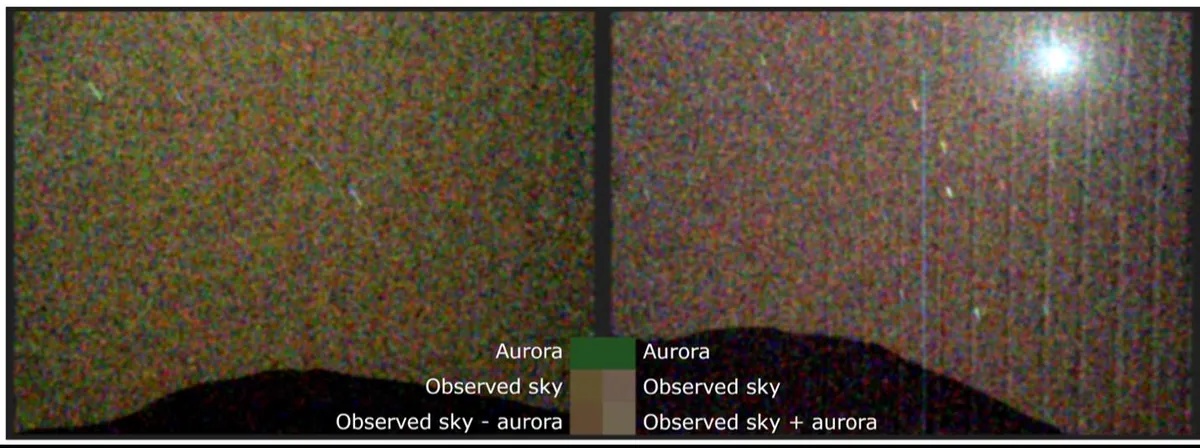
On March 15, 2024, during the peak of the current solar cycle, an extraordinary event unfolded as the Sun unleashed a powerful solar flare along with a significant coronal mass ejection (CME). This massive explosion of gas and magnetic energy propelled a vast quantity of solar energetic particles through space, resulting in spectacular auroras across the solar system. Notably, these captivating light displays were observed on Mars for the first time by NASA’s Perseverance Mars rover, marking a groundbreaking achievement in planetary science.
Elise Knutsen, a postdoctoral researcher at the University of Oslo and the lead author of the study published in Science Advances, expressed excitement over this monumental discovery. “This exciting discovery opens up new possibilities for auroral research and confirms that auroras could be visible to future astronauts on Mars’ surface,” she stated.
Auroras on Earth are formed when solar particles collide with the planet's global magnetic field, channeling them toward the poles where they interact with atmospheric gases to produce light. The most common hue, green, results from excited oxygen atoms emitting light at a wavelength of 557.7 nanometers. For years, scientists speculated that similar green light auroras might also exist on Mars, albeit fainter and more challenging to detect due to Mars’ absence of a global magnetic field.
Instead of traditional auroras, Mars experiences solar energetic particle (SEP) auroras, which were first discovered by NASA’s MAVEN (Mars Atmosphere and Volatile EvolutioN) mission in 2014. These auroras occur when super-energetic particles from the Sun strike the Martian atmosphere, causing it to glow across the night sky. While MAVEN observed these phenomena in ultraviolet light from orbit, the detection of SEP auroras in visible light from the Martian surface had never been achieved until now.
To seize this unique opportunity, Knutsen and her team meticulously modeled the ideal configuration for the Perseverance rover’s SuperCam spectrometer and Mastcam-Z camera to capture the SEP aurora in visible light. Timing was crucial, as they aimed to coincide their observations with significant CMEs. “The trick was to pick a good CME, one that would accelerate and inject many charged particles into Mars’ atmosphere,” Knutsen explained.
Collaboration played a pivotal role in this endeavor. Teams at NASA’s Moon to Mars (M2M) Space Weather Analysis Office and the Community Coordinated Modeling Center (CCMC) at NASA’s Goddard Space Flight Center worked together to provide real-time analysis of solar eruptions. When Christina Lee, a space physicist at the University of California, Berkeley, received an alert regarding the March 15 CME, she promptly notified the Mars missions’ science teams, enabling them to prepare for potential impacts of the incoming solar storm.
As anticipated, the CME reached Mars, allowing Perseverance to capture stunning images of the aurora, which appeared nearly uniform across the Martian sky at an emission wavelength of 557.7 nm. To validate the presence of solar energetic particles during this observation, the team referred to MAVEN’s SEP instrument and corroborated their findings with data from the European Space Agency’s Mars Express mission. This successful cross-mission collaboration allowed them to glimpse a phenomenon previously unseen from Mars’ surface.
“This was a fantastic example of cross-mission coordination. We all worked together quickly to facilitate this observation and are thrilled to have finally gotten a sneak peek of what astronauts will be able to see there someday,” said Shannon Curry, MAVEN principal investigator and research scientist at the Laboratory for Atmospheric and Space Physics at the University of Colorado Boulder.
By aligning Perseverance's observations with MAVEN’s SEP measurements, the teams confirmed that the observed 557.7 nm emission stemmed from solar energetic particles. This correlation suggests that future astronauts exploring Mars may witness similar auroras. “Perseverance’s observations of the visible-light aurora confirm a new way to study these phenomena that’s complementary to what we can observe with our Mars orbiters,” noted Katie Stack Morgan, acting project scientist for Perseverance at NASA’s Jet Propulsion Laboratory.
Understanding auroras and the conditions that generate them on Mars is crucial as NASA prepares for human exploration of the Red Planet.
The Mars 2020 Perseverance mission is a key element of NASA’s ongoing Mars Exploration Program, which seeks to advance our knowledge of the Red Planet in preparation for future human missions. Managed by Caltech’s Jet Propulsion Laboratory, Perseverance is designed to explore Mars’ surface and gather data that could inform human exploration efforts. Similarly, the MAVEN mission, also part of NASA’s Mars Exploration Program, is led by the Laboratory for Atmospheric and Space Physics and is managed by NASA’s Goddard Space Flight Center.
With these groundbreaking discoveries and advancements in technology, the future of auroral research on Mars seems promising, paving the way for human explorers to witness the beauty of Martian auroras firsthand.